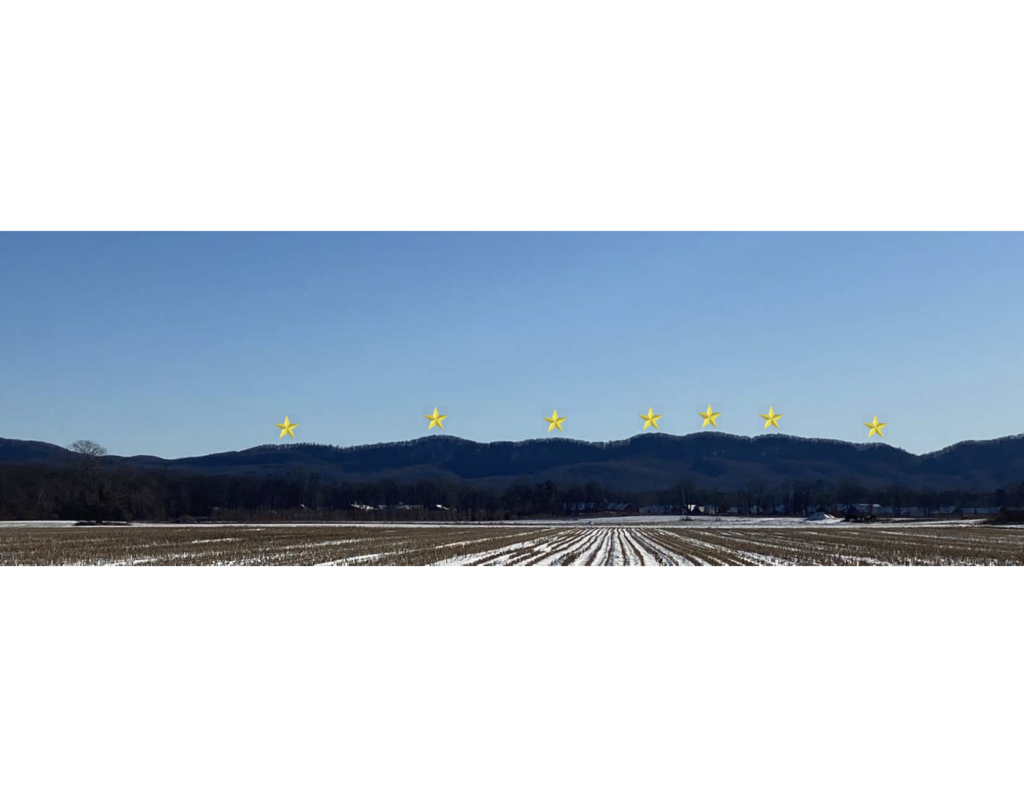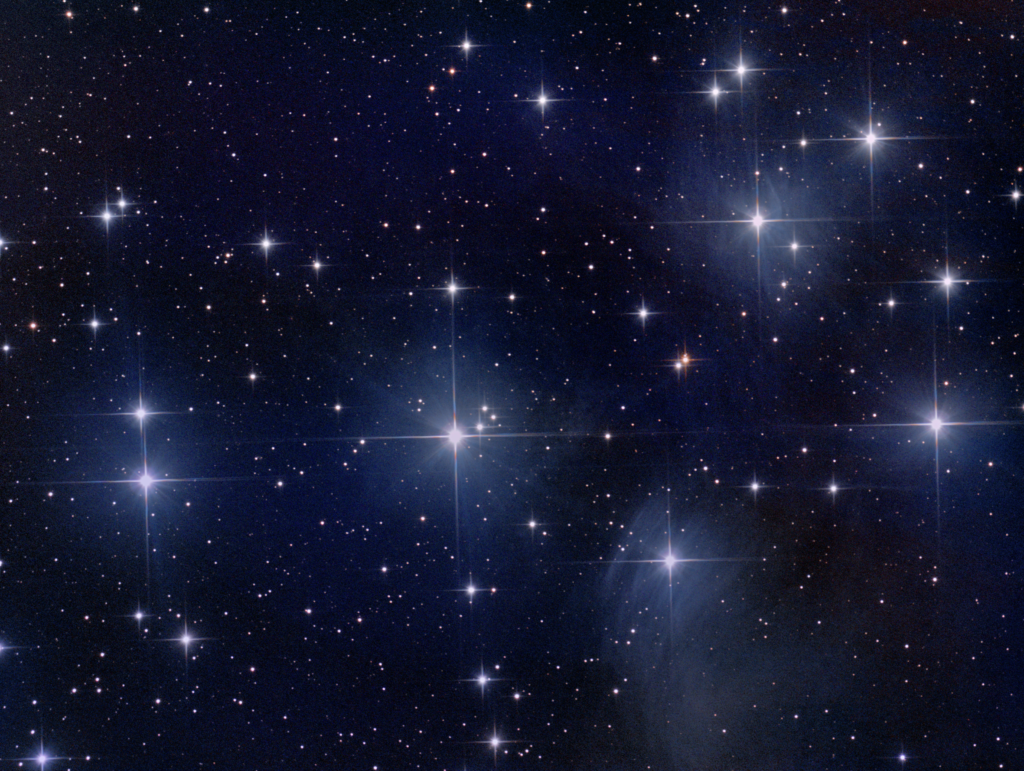Almanac: Sisters

The Seven Sisters of the Holyoke Range viewed from Hadley. Photo: Stephen Braun
It was snowing with gathering intensity last weekend as I set off from a trailhead below Mt. Holyoke for a boots-on-the-ground exploration of a mystery that has been nagging me for some time. My plan was to do a loop that would involve hiking along the tops of what many maps label “The Seven Sisters”—relatively low bumps between Mt. Holyoke to the west and Mt. Hitchcock to the east.
The thickening snow added some challenge to an already sketchy plan. I had seen, on a digital map, some un-named trails below the Seven Sisters on the northside of the ridge. My idea was to hike the ridge then return via these possibly non-existent trails. The snow, however, would obscure faint trails as well as making the footing dicey. At this time of year trails around here tend to be covered with oak leaves, which are slippery enough even when dry but which become diabolical with the extra lubrication of snow.
So: uncertain trails; worsening weather; treacherous footing. As a friend of mine was fond of saying in similar situations: “What could possibly go wrong?”
About 15 minutes later, as I climbed my first Sister from Taylor Notch, I encountered a man limping slowly along the trail, hobbled by a sprained ankle. He was being steadied by two companions, but it was a reminder of at least one thing that could possibly go wrong. I proceeded with extra caution.
The goal of my little expedition was to identify the aforementioned sisters. No map I could find actually did that—the label was just applied to the whole bumpy stretch. As you can see from the photo above, it’s not entirely obvious, from a distance, that there even are seven bumps. From some vantage points it looks more like six, from others more like 8. The only reason it would possibly matter is that if, indeed, there are seven mini-mountains along the ridge, then it seems to me that they should be identified and named for the original Seven Sisters: the ones in the sky.

The Pleiades star cluster, popularly known in our culture as the Seven Sisters, is associated with a rich and ancient mythology that spans cultures. In the Greek tradition, the celestial Seven Sisters are: Maia (the eldest), Electra, Taygete, Alcyone, Calaeno, Sterope, and the younges, Merope. They were the children of Atlas and the sea-nymph Pleione. That makes Atlas an impressive multi-tasker—he not only held the world on his shoulders, he managed to father seven children while doing so.
How the daughters got to be stars depends on which of many versions of the story you read. In one tale, the great hunter Orion was chasing the daughters and, out of pity for the young girls, Zeus transformed them into doves, and, then into stars. It would have been altogether fairer if Zeus had just zapped Orion with a few lightning bolts below his famous belt, but the Greek mythmakers were notably misogynistic, so it’s not surprising the onus fell on the women. In any event, the easiest way to find the Pleiades, which are high in the night skies these days, is to locate Orion and then scan west for the tight little star cluster that somewhat resembles a miniature big dipper.
Although many other cultures have noted seven stars in the Pleiades and created myths about them, some recognize only six. In fact, most people can only see six without optical aide. (Interesting factoid: the Subaru car logo has six stars because “Subaru” is Japanese for what we call the Pleiades, except they recognize only the six commonly-visible stars as members of the group.) If you have binoculars, you owe it to yourself to go out some cloudless night and take a peek at the Pleiades…it’s like a jewelbox of sparkling blue-tinted gems.
Several legends attempt to explain why most people only see six Pleiades. For example, Merope is said to have fallen in love with the mortal Sisyphus, and because she married him, she faded away, becoming the “lost sister.” Other legends involve Electra or Celaeno. It’s possible that one of the seven stars has actually faded a bit in the past two thousand years. Some stars do vary quite a bit in brightness, and sometimes in unpredictable ways. (The giant red star in Orion, Betelgeuse, recently dimmed considerably, leading to speculation that it was ready to blow up…but it was only temporarily veiled by some cosmic dust.)
As for our local nano-peaks, it is possible that whoever first came up with the Seven Sisters moniker was thinking of the collegiate sisters, not the celestial ones: Smith, Mt. Holyoke, Radcliffe, Barnard, Vassar, Wellesley, and Bryn Mawr. But the Pleiades have the more ancient lineage. If names are to be chosen for these diminutive bumps, I think we should defer to mythology.
But back to our story. Even under the less-than-ideal conditions last week, hiking along the Seven Sisters was fun. It’s like riding a roller coaster in slow motion: steep, scrambling ups and downs with little breathers between, some with lovely views of the river valley to the north. I counted as I went, and both my eyes and my quads confirmed the first six relatively discrete “peaks.” The easternmost Sister, however, is more like a double peak than a single entity, an inconvenient fact that I’m happy to ignore in order to preserve the satisfyingly prime number seven and its myriad connections.
I slipped and slithered way down that last bump to the valley on the west flank of Mt. Hitchcock and then struck off along a vague and un-blazed path leading down and westward. Before long the “trail” evaporated and I found myself alone in a woods so quiet that the only sound was the soft pelting of snowflakes on my hood. It was a beautiful day for bushwhacking, and relatively easy, given the obvious landmark of the Holyoke Range on my left. Eventually I came upon an old road that I followed even though it meandered off what I guessed was my desired heading. I ended up in somebody’s back yard, which was briefly puzzling, but that meant I was close to Rt. 47. I skirted the house, found another trail, and, just as the adventure was beginning to wear thin, I found the yellow-blazed trail on which I had begun.
Having convinced myself that our local Seven Sisters are real, I wondered why nobody has bothered to formalize the situation. I can imagine a dedicated “Seven Sisters” trail, with signs at the tops of each mini-peak identifying each sister and explaining a bit of her specific mythology. The peaks could be named starting with the elder Maia to the east and ending with Merope on the west. Who gets to decide such things? If any of you gentle readers have any ideas, post them below!
Almanac is a regular Indy column of observations, musings, and occasional harangues related to the woods, waters, mountains, and skies of the Pioneer Valley. Please feel free to comment on posts and add your own experiences or observations.

This is fascinating Steve. I can’t believe you did that hike in the snow. We think you should gather all your columns into a book. The column on black squirrels would almost guarantee that it would be a best seller.
I agree with Maura, especially about Steve’s black squirrels column — and the many comments it generated ;-)!
As far as the “peaks” (local maxima for height) of the Holyoke Range, here’s what I can see on on my topographic maps:
West of The Notch there do appear to be (many) more than 7 “sisters” — the peaks strictly between Mt Holyoke and Mt Hitchcock — and the only peaks above 300m are Mt Hitchcock (305m) and its slightly higher “cousin” Bare Mountain (309m) to its east.
East of The Notch stands the highest “cousin” among them, Mt Norwottuck at 337m — on my topographic maps it appears to have several nearby sub-peaks over 300m — followed by the much lower but also multi-peaked Long Mountain.
Glad you made it home, Steve, with your ankles intact. At least by hiking in subfreezing weather you minimized the chance of bringing home myriad “nymphs” of the order Ixodida — ticks! 😉